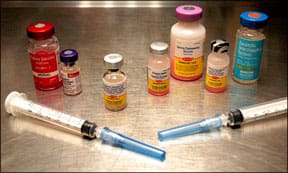Dog vaccinations are something that every dog owner should be educated about, and yet few seem to think about them at all, except to wonder about the need for them after they get a new dog. However, many people base this concern on the vet bill, rather than worries about the potential for side effects in their dogs!
Immunology expert Ronald Schultz, PhD, Diplomate ACVIM (American College of Veterinary Internal Medicine), has spent much of his career studying animal vaccines. Dr. Schultz is professor and chair of the Department of Pathobiological Sciences at the University of Wisconsin-Madison School of Veterinary Medicine, and has more than 40 years’ experience in the field of immunology. His long-time university employment – as opposed to a career in industry – has provided him with a unique position of neutrality from which to observe the dog vaccination industry.

Dr. Schultz is on the American Animal Hospital Association (AAHA) Canine Vaccine Task Force and the American Association of Feline Practitioners (AAFP) Feline Vaccine Task Force; these two organizations provide guidelines to the veterinary industry for canine and feline vaccination programs. Recently, Dr. Schultz was also asked to help develop the canine and feline vaccination guidelines for the World Small Animal Veterinary Medical Association.
Known for his research on the duration of immunity (DOI) of common canine vaccinations through serological (antibody titers) and challenge studies as far back as the 1970s, Dr. Schultz co-published a paper in 1978 in which triennial vaccination was recommended over then-standard annual vaccination. It took 25 years, but in 2003, the American Animal Hospital Association (and the American Veterinary Medical Association) at last supported his thesis that canine “core” vaccines need not be given more often than every three years.
Dr. Ron Schultz was also one of the few canine vaccine experts to point out that the yearly recommendation included on vaccine labels was not based on any scientific studies nor ever scientifically validated!
Most vaccine makers today perform duration of immunity studies in order to ensure the minimum duration of immunity for their products; they have to be able to guarantee that their products convey immunity in most animals for a minimum period. But they lack any sort of incentive to run DOI studies to determine the maximum period of immunity conveyed by their products; indeed, if the products work longer, people will need less of them.
Long studies are astronomically expensive. According to Dr. Schultz, the cost of running a three- to five-year DOI trial involving 20 animals is roughly a half million dollars.
Since the industry won’t do it, dog owners will. Among many other research projects, Dr. Schultz’ current work includes partnering with W. Jean Dodds, DVM, on the privately funded Rabies Challenge Study. This study is testing the hypothesis that current rabies vaccines offer protection of at least five to seven years, if not longer. The study is overseen by a 501(c)(3) non-profit, the Rabies Challenge Fund Charitable Trust, which accepts donations to cover the costs of this important project. (For more information on this worthy project, see the Rabies Challenge Fund.)
Dog Vaccine Basics
Unlike some busy professors and research scientists, Dr. Schultz also frequently makes himself available to the communities who are most interested in his work – in this case, dog and cat enthusiasts.
Earlier this year, I had the honor of arranging for Dr. Schultz to make a presentation to a club I am involved with, the American Bouvier Rescue League in Alpharetta, Georgia. In his talk, Dr. Schultz discussed the pros and cons of types of vaccines (i.e., modified live vaccines [MLV], killed, etc.), the immune response to vaccines, vaccine protocols (core and non-core), risk/benefit assessments, titers, and adverse reactions.
The following are topics Dr. Schultz covered in his talk. I summarized points in his presentation; Dr. Schultz generously offered to proofread my summation for accuracy.
Duration of immunity
Duration of immunity is the length of time an animal is protected from a disease.
Antibody titers
A titer is a measurement of antibody to a specific virus (or other antigen). The antibody is in the liquid portion of blood. With parvo, distemper, and adenovirus titers, the presence of any measurable antibody shows protection in vaccinated dogs older than 16 weeks of age. The positive antibody test result is fairly straightforward; it shows you don’t have to revaccinate for these viruses. A negative antibody test result shows you need to vaccinate or revaccinate.
Using vaccine antibody testing as a means to assess vaccine-induced protection is likely to result in preventing the animal from receiving needless and unwise booster vaccinations.
Serological study, challenge study
A serological study measures the animal’s antibody levels (titer) against a specific virus or agent. In very simple terms, a challenge study is one in which animals are injected or “challenged” with the infectious agent, post-vaccination, and observed for signs of disease.
“Core” vaccines for dogs
Dr. Schultz considers the following vaccines to be the “core” (or basic) vaccines that every dog should receive: canine distemper (CDV), canine parvovirus 2 (CPV-2), canine adenovirus 2 (CAV), and rabies. Core vaccines protect animals from severe, life-threatening diseases that have global distribution.
Puppies should not be vaccinated before five weeks of age because their immune systems are immature, and the presence of maternal antibodies can block the puppy’s immune system from responding appropriately. Ideally, in a nonshelter situation, the first puppy shots (CDV, CPV, CAV) should be given at eight to nine weeks of age. The rest of the series should be administered with a minimum of two weeks between doses, but preferably three to four weeks, to give the immune system time to properly respond. Thus, ideally, the next shots would be at 11 to 12 weeks, followed by the last at 14 to 16 weeks.

A series is necessary because we do not know at what point the maternal antibodies are low enough not to block the puppy’s immune response. Research shows that less than 50 percent of puppies will respond at six weeks; 75 percent at nine weeks; 90 percent at 12 weeks; and by 14 to16 weeks, close to 100 percent will respond. However, a titer can be checked two or more weeks after the last shot in the series to see whether the puppy’s immune system responded in the desired fashion.
After that, recommendations are to “boost” one year later, then vaccinate healthy dogs not more often than every three years thereafter, or better yet, run antibody titers. This, again, is a conservative approach from a veterinary standpoint as Dr. Schultz and other researchers have data showing that after the initial round of vaccines, most dogs will have immunity for life from CDV, CPV, and CAV.
Rabies
The rabies vaccine is the only vaccine mandated by law in most states. The first rabies vaccine should be given no earlier than 12 to 16 weeks of age, or as local law dictates, then again one year later. The three-year vaccine, if accepted by state law, can be administered at that time, and then every three years thereafter. The rabies vaccine should be administered by itself at a later date, in a different area on the dog’s body, from the other three core vaccines. Some states offer exemption policies from the rabies vaccine for dogs who have medical conditions that contraindicate vaccination.
The rabies vaccine is the most reactive virus vaccine, and it is the only core vaccine that requires a minimum DOI study to be approved by the USDA.
Despite a French study that has shown (by challenge) a DOI of five years, and serological studies have shown a DOI of at least seven years, currently, the USDA has approved only studies of just three years’ duration for the rabies vaccine. This is why the Rabies Challenge Fund Study, which will follow the strictly defined federal APHIS/USDA standards for licensing rabies vaccines in concurrent five- and seven-year challenge trials, is so critically important to our dogs’ health.
Annual vaccination
The adage that “if it doesn’t help, it won’t hurt” is not true for vaccines. If a dog were vaccinated (and did not require it), the dog would not respond with a significant increase in antibody titer, but might develop a hypersensitivity to vaccine components (e.g., fetal bovine serum). Furthermore, the dog should not be revaccinated since the vaccine could cause an adverse reaction (hypersensitivity disorder).
In a 1992 paper Dr. Schultz wrote, “Extending the revaccination intervals for canine core vaccines does not place the animal at increased risk to developing vaccine preventable disease, but it does reduce the potential for adverse reactions.” Even the three-year protocol is very conservative, as studies point to the core vaccines having a minimum DOI of seven years or more. This is why running a titer, versus vaccinating even only every three years, is preferable.
Dogs with unknown vaccination histories (rescue or shelter dogs)
For a rescue dog with an unknown vaccine history, the first choice would be to run antibody titers, particularly if it is an older dog. Otherwise, with a healthy dog, Dr. Schultz would recommend vaccinating for parvo, distemper, adenovirus, and rabies. A conservative approach is to give two doses of CPV, CDV, and CAV, three to four weeks apart. However, one dose is considered protective and acceptable in a dog over sixteen weeks of age, according to Schultz’ research.
The rabies vaccine would be administered per state law (typically an initial dose, followed by another one year later, then on a three-year schedule). A dog coming in with a known vaccine history should not immediately be re-vaccinated; use the three-year time frame from the date of the last vaccine, or better yet, run a titer, especially if there is doubt about the validity of the shot records.
Don’t “do it all at once”
In the short-term interest of time and money, dogs are often vaccinated while at the vet clinic for spay/neuter surgery. However, it is best not to do this; the dog may develop a hypersensitivity reaction and vomit, leading to an increased risk of aspiration. Also, anesthetic agents may be immunomodulatory. Whenever possible, vaccinate prior to a surgical visit.
“Non-core” vaccinations
Non-core vaccinations include para-influenza, Bordetella bronchiseptica (kennel cough), Borrelia burgdorferi (Lyme), and leptospirosis. These vaccines should be administered only to dogs whose geographical location, local environment, or lifestyle places them at risk of contracting each of the specific infections.
Interestingly, as opposed to the viral vaccines, immunity from bordetella and lepto vaccines often lasts less than one year because they are bacterial diseases. And neither actually prevents the disease, but rather manages the disease and its severity. Lepto vaccines are the most reactogenic of all the vaccines, even more so than the rabies vaccines.

Coronavirus (CCV) and giardia vaccines are not recommended, as the 2006 AAHA Guidelines note, “Prevalence of clinical cases of confirmed CCV disease does not justify vaccination.”
If vaccinating a puppy with non-core vaccines, in general, with the exception of intranasal bordetella, which can be given with the core vaccines, the viral vaccinations should be given first, and the bacterials should not be mixed.
Need for vaccination
A study of shelter dogs revealed that only 50 percent were vaccinated. To achieve “herd (population) immunity” and prevent epidemic outbreaks, at least 75 percent of the population should be vaccinated. Clearly these diseases still exist in our society, but our desires to protect our dogs both from disease and the dangers of overvaccination do not have to be mutually exclusive. A well thought-out vaccination protocol for our dogs can help us to protect them from disease, yet at the same time, reduce the risk of adverse reactions.
Dr. Schultz notes that if the public could be educated to have pets older than 16 weeks of age vaccinated even once with the core vaccines, this would help immensely with herd immunity. With rabies, one vaccine is better than none in offering protection, but a minimum of two is considered better yet. The CDC notes that “no documented vaccine failures occurred among dogs or cats that had received two [rabies] vaccinations.”
Individual Immunization Decisions
The most important message from Dr. Schultz’ talk is that there is no one vaccine program; vaccine programs must be tailored to the specific needs of each animal. Although there is a tendency to want to treat all dogs the same, the program should be designed for the individual, not the masses. Often, the burden falls on the shoulders of the dog’s guardian to ensure that the pet receives the optimal program that takes into account his age, health, environment, and lifestyle.







My five year old. seven pound dog received four vaccinations:
Leptospirosis 4 way
Bordetella injection
Rabies Defensor
5in1 (DA2P + parvovirus
Twenty minutes after the vaccinations, she experienced adverse reactions; falling over, throwing up, inability to walk. She spent seven days at the emergency vet and received an x-ray, IV fluids, MRI, spinal tap and IV medications and wouldn’t eat. She also had a fever. She’s had vaccinations over the years without any problem.
Considering her symptoms appeared within minutes of receiving these vaccines, I believe either one or more of them, or administering all four at one time, caused her reaction.
But I thought I’d ask a professional, thus, I would appreciate your input.
By the way, she slowly recovered and from all appearances, she’s back to her old self.
I hope to hear from you so I can get some clarification.
I thank you in advance.
It’s good to know that there’s a way to get an idea of what vaccines a rescue dog has gotten with antibody titers. That’s really helpful since me and my husband just adopted a stray and are looking to get him vaccinated. We aren’t sure what the dog’s vaccine history is so just to be safe we are going to get him the vaccinations you recommended. It will be reassuring to know that our new rescue won’t catch any avoidable illnesses if we get him vaccinated.